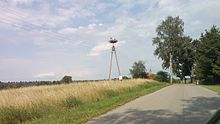Malinka (Wydminy)
| Malinka | ||
|---|---|---|

|
|
|
| Basic data | ||
| State : | Poland | |
| Voivodeship : | Warmia-Masuria | |
| Powiat : | Giżycko | |
| Gmina : | Wydminy | |
| Geographic location : | 53 ° 56 ' N , 21 ° 58' E | |
| Residents : | 89 (2010) | |
| Postal code : | 11-510 | |
| Telephone code : | (+48) 87 | |
| License plate : | NGI | |
| Economy and Transport | ||
| Street : | Ext. 656 : Ełk - Zelki ↔ Staświny / DK 63 | |
| Rail route : | no rail connection | |
| Next international airport : | Danzig | |
Malinka [ maˈlinka ] ( German Mallinken , 1930 to 1945 Birkfelde ) is a village in the Polish Warmia-Masurian Voivodeship , which belongs to the rural community of Wydminy ( German Widminnen ) in the powiat Giżycki (district of Lötzen ).
Geographical location
Malinka is located in the eastern center of the Warmian-Masurian Voivodeship, 17 kilometers southeast of the district town of Giżycko (Lötzen) .
history
The small Gutsdorf called Malinken after 1871 and until 1930 Mallinken was first mentioned in 1564. At that time, Duke Albrecht prescribed the inheritance of Neuhoff (Zelki in Polish) to Freiherr Wolf zu Heydeck , including the Malinken estate.
In 1874 the Gutsdorf was incorporated into the Neuhoff district. This belonged to the district of Lötzen in the administrative district of Gumbinnen (1905 to 1945: administrative district of Allenstein ) in the Prussian province of East Prussia . At the same time, the village was also assigned to the Neuhoff registry office . The inhabitants of Gutsbezirks Mallinka amounted in 1910 to 98th
Due to the provisions of the Versailles Treaty , the population in the Allenstein voting area , to which Mallinken belonged, voted on July 11, 1920 on whether it would continue to belong to East Prussia (and thus to Germany) or join Poland. In Mallinken, 60 residents voted to remain with East Prussia, Poland did not vote. On October 17, 1928, the manor district of Pammern ( Pamry in Polish ) was incorporated into Mallinken, which had recently been converted from an estate into a rural community .
On May 10, 1930 Mallinken was renamed "Birkfelde". The population rose to 337 by 1933 and was still 302 in 1939.
In 1945, the village came in consequence of the war with the entire southern East Prussia to Poland and received the Polish form of the name "Malinka". Today the village is the seat of a Schulzenamt ( Polish sołectwo ) and thus a district of the rural community Wydminy (Widminnen) in the powiat Giżycki ( Lötzen district ), before 1998 the Suwałki Voivodeship , since then it has belonged to the Warmia-Masurian Voivodeship .
Religions
Until 1945 Mallinken was parish in the Protestant church Neuhoff (Zelki) in the church province of East Prussia of the Church of the Old Prussian Union , only the western part of the village belonged to the Church of Milken (Miłki). In addition, the village belonged to the Catholic Church of St. Bruno Lötzen in the Diocese of Warmia .
Today Malinka in the Protestant church Wydminy , a filial community of the parish Giżycko in the diocese Mazury the Evangelical Augsburg Church in Poland , and in the Catholic church Wydminy in the Diocese of Elk (Lyck) of the Roman Catholic Church in Poland incorporated.
traffic
Malinka is located on the voivodship road DW 656 , which connects the district town Ełk ( German Lyck ) with the powiat Giżycki (district Lötzen ) and via the state road 63 (former German Reichsstraße 131 ) from Staświny (Staßwinnen , 1938 to 1945 Eisermühl) the district town Giżycko (Soldering) achieved.
Web links
Individual evidence
- ↑ a b c d e Mallinken
- ↑ Polish Postal Code Directory 2013, p. 760
- ↑ Dietrich Lange, Geographical Location Register East Prussia (2005): Birkfelde
- ^ Rolf Jehke, Neuhoff district
- ↑ Uli Schubert, community directory, Lötzen district
- ^ Herbert Marzian ; Csaba Kenez : "Self-determination for East Germany - Documentation on the 50th anniversary of the East and West Prussian referendum on July 11, 1920"; Editor: Göttinger Arbeitskreis , 1970, p. 80
- ^ Michael Rademacher: German administrative history from the unification of the empire in 1871 to the reunification in 1990. Landkreis Lötzen (Polish Gizycko). (Online material for the dissertation, Osnabrück 2006).
- ↑ a b Walther Hubatsch , History of the Protestant Church in East Prussia , Volume 3 Domumente , Göttingen, 1968, p. 492


